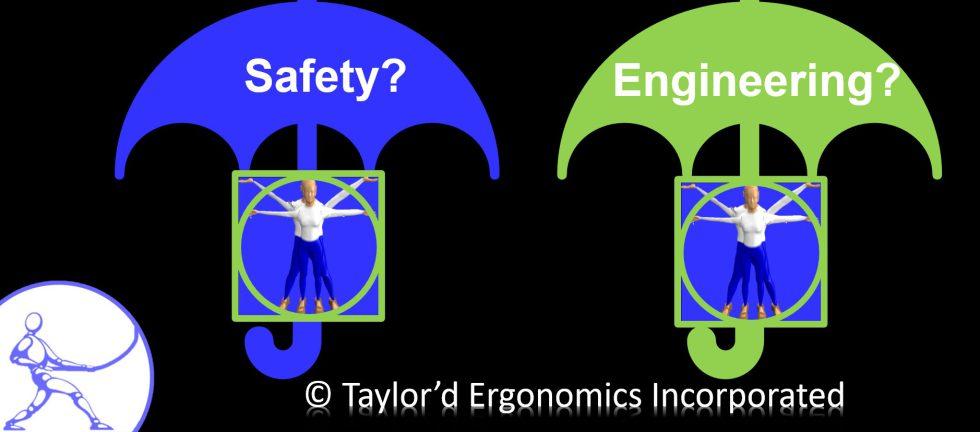Most of our clients hire us because they need help to reduce sprain/strain injuries. We are typically contacted by the Human Resources department or, more specifically, Health and Safety. This is a natural consequence of the way most organizations see ergonomics: fitting work to people so strain/sprain injuries can be avoided.
As we’ve pointed out in a recent article, key injury metrics in most organizations point toward ergonomics as a solution.
-
- Strains/sprains are high? Implement an ergo program.
-
- Back injuries are common? Use ergonomics to address the hazards.
-
- Most common event associated with injury is overexertion? You need ergonomics!
So, if injuries suggest that ergonomics is needed, is there any reason for ergonomics to stand outside the safety umbrella?
The safety department’s priority, in many organizations, is to implement programs that prevent fatalities and minimize exposure to litigation (fines, penalties). Preventing a death or critical injury will always be more important than avoiding a sore shoulder. (No argument here.) Safety professionals can facilitate change by promoting workplace practices that comply with laws and regulations. No one argues that a guard needs to be installed to cover a pinch point, or exposure to chemicals needs to be limited.
However, the laws that protect workers from strain/sprain hazards are not as well defined, as we discussed last week. Sometimes, strain/sprain injuries start to look like part of the cost of doing business:
-
- They’ve always been there.
-
- It’s hard to identify a specific cause.
-
- We can’t imagine how we’d do things any other way.
-
- We aren’t going to be fined for non-compliance.
-
- A strain/sprain hazard is unlikely to lead to a fatality or critical injury.
Safety professionals have plenty to worry about, before they get to strains and sprains. And that’s probably why they call us for help. (And we’re happy to answer that call, of course!)
What if ergonomics stood under the engineering umbrella?
I’ve been in situations where ergonomics and engineering were at odds – the engineer wanted to improve efficiency at the expense of muscle recovery time. To be fair, this isn’t as common as it used to be. We all generally agree that workers perform better when the job is designed within their capabilities.
I also think ergonomists are less likely, today, to suggest assigning more people to do the work, or slowing down the line. So perhaps we are also getting easier to get along with. 🙂
In my experience, ergonomics projects with engineers tend to be more time-pressured. They require more “imagination” (and experience) for us to envision how a job will be performed, if we’re working from drawings. Engineers usually want to understand the data that back up our analyses and recommendations. They are able to help us weed through what is possible and practical, and what is not. Ultimately, engineers are often responsible for implementing our recommendations, regardless of how the project started, so our recommendations need to be written with them in mind.
I encourage our ergonomists to consider efficiency and performance quality when researching interventions. Even if the reason we got involved was strain/sprain injury risk, we can and should synergize with engineering to find solutions that help people, and therefore organizations, to perform better.
In some organizations, the ergonomist is part of the engineering department. We have some clients who have always brought us in through engineering. These tend to be companies who are expanding; they typically want to ensure that new equipment is optimized to avoid injuries that have occurred with similar equipment in the past. We’ve always prided ourselves in providing very specific recommendations for these projects, to make implementation as easy as possible.
Ultimately, ergonomists need to collaborate with safety AND engineering professionals on virtually every project. As consulting ergonomists, we are happy to be sheltered under either umbrella!
Need some help considering ergonomics in design?
Contact carrie@taylordergo.com to discuss a specific project.
Or join us for some training:
Ergo Design Workshop in Cambridge on October 26
Productivity, Employee Engagement, and Quality through Ergo Workshop in Cambridge on November 9


